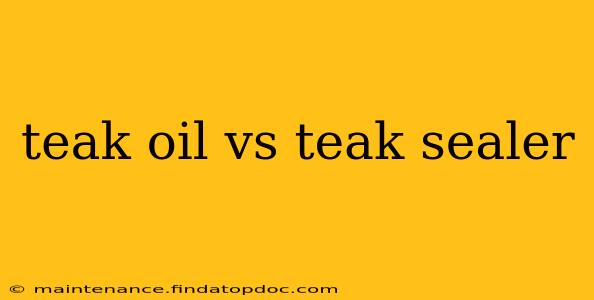Choosing between teak oil and teak sealer can feel overwhelming, especially when you're eager to protect your beautiful teak furniture. Both products aim to preserve the wood's natural beauty, but they achieve this in fundamentally different ways. Understanding these differences is crucial for making the right choice for your needs. This guide will delve into the specifics of each product, highlighting their pros and cons to help you decide which is best for your teak.
What is Teak Oil?
Teak oil is a penetrating oil that soaks into the wood, nourishing and protecting it from within. It doesn't form a surface film like a sealer, but instead enhances the wood's natural color and water resistance. Think of it as a moisturizer for your teak. It replenishes the wood's natural oils, preventing it from drying out and cracking.
Pros of Using Teak Oil:
- Enhances Natural Beauty: Teak oil brings out the rich, golden tones of the teak wood, highlighting its natural grain.
- Penetrates Deeply: It provides protection from within, offering long-lasting hydration and preventing weathering.
- Easy Application: Generally easy to apply, requiring minimal preparation.
- Allows Wood to Breathe: The wood can still expand and contract naturally, reducing the risk of cracking.
Cons of Using Teak Oil:
- Requires More Frequent Application: Teak oil needs reapplication more often than sealers, typically every 6-12 months, depending on exposure to the elements.
- Less Protection from UV Rays: Offers less protection against UV degradation compared to sealers.
- May Not Be Suitable for All Climates: In extremely harsh climates with heavy rain and sun exposure, frequent application may still not provide sufficient protection.
What is Teak Sealer?
Teak sealer forms a protective barrier on the surface of the wood, acting as a shield against the elements. Unlike teak oil, it doesn't penetrate the wood. Instead, it creates a film that protects against moisture, UV rays, and other environmental stressors.
Pros of Using Teak Sealer:
- Longer-Lasting Protection: Provides more durable protection against weathering and UV damage than teak oil.
- Superior Water Resistance: Offers excellent protection against moisture, preventing water damage.
- Less Frequent Application: Requires less frequent reapplication than teak oil.
Cons of Using Teak Sealer:
- Can Alter the Wood's Appearance: May slightly alter the wood's natural color and texture, potentially masking its beautiful grain.
- Can Peel or Chip: If not applied correctly or if the wood expands and contracts significantly, the sealer can peel or chip.
- May Prevent the Wood from Breathing: This can potentially lead to trapped moisture and damage in extreme climates.
Which is Better: Teak Oil or Teak Sealer?
The "better" choice depends entirely on your priorities and climate.
-
Choose teak oil if: You prioritize preserving the natural beauty of the teak, prefer a more natural approach, and are willing to apply it more frequently. This is ideal for furniture that's somewhat sheltered from the elements.
-
Choose teak sealer if: You need maximum protection from the elements, prefer longer-lasting protection, and are less concerned about slightly altering the wood's appearance. This is a good choice for furniture exposed to harsh weather conditions.
What are the Different Types of Teak Sealers?
There are several types of teak sealers available, each with its own set of properties:
- Water-based sealers: These are generally easier to apply and clean up, and offer good UV protection.
- Oil-based sealers: These tend to offer superior water resistance but can take longer to dry and require solvents for cleanup.
How Often Should I Apply Teak Oil or Sealer?
The frequency of application depends on several factors, including the type of product, the climate, and the level of sun and rain exposure. As a general rule:
- Teak oil: Every 6-12 months, or more frequently in harsh climates.
- Teak sealer: Every 1-3 years, depending on the product and environmental conditions.
Can I Use Teak Oil and Sealer Together?
While it's not typically recommended to use them simultaneously, you could apply teak oil first to nourish the wood, followed by a sealer to provide additional protection. However, ensure the oil is completely dry before applying the sealer.
What are the best brands for teak oil and sealer?
Many reputable brands offer both teak oil and sealers. Researching reviews and comparing products based on your specific needs is key to finding the best option for your teak furniture. Always follow the manufacturer's instructions for application and maintenance.
By carefully considering these factors and choosing the right product, you can ensure your teak furniture remains beautiful and protected for years to come. Remember to always prepare the surface properly before application and follow the manufacturer's instructions diligently.
